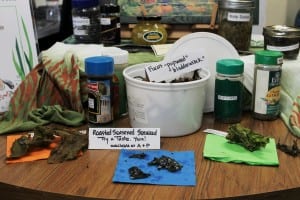 Food is everywhere in Alaska. The trick is, identifying that food in the wild. The University of Alaska Southeast in Ketchikan hosted a seminar Tuesday night discussing how to forage on the beach.
Food is everywhere in Alaska. The trick is, identifying that food in the wild. The University of Alaska Southeast in Ketchikan hosted a seminar Tuesday night discussing how to forage on the beach.
Classrooms in Ketchikan’s Maritime Training Center quickly filled beyond regular capacity Tuesday night for a seminar discussing beach food and foraging. Event organizer Priscilla Shulte said they were surprised at the crowd of nearly 100 people.
“This is a wonderful turnout. You know, there’s a lot of things we would do differently if we knew there were going to be this many people… I was going to be happy if 25 people came.”
Side rooms featured basket-weaving using tree bark, and aerial drones used to find ancient fish traps and clam gardens. However, the main event focused on food. Specifically, what items you can eat on the beach, what to be careful of, and how to prepare certain items. There were tables set up to sample fried seaweed and pickled beach asparagus, and others to give general information. One table even featured a microscope to look at the microorganisms found in Ketchikan’s waters.
Biologist Barbara Morgan wanted people to see these organisms, because they can be deadly to those who harvest and eat their own mussels and clams. She says that in Ketchikan she hasn’t found the deadly strain of phytoplankton that causes Paralytic Shellfish Poisoning, but Morgan still warns of the danger associated with eating these types of organisms when they haven’t been tested.
“Only way to be safe is to only eat shellfish that has been tested by a DEC lab. So anything in a grocery store…anything from a certified shellfish farmer in the area, all of them have to have all of their product tested in a DEC lab, so that’s safe. The rest of it, you’re running a risk.”
She says one man who survived PSP could actually hear what was happening as he was paralyzed.
“The person actually survived and was able to tell the story later that they were able to hear the doctors talking about pulling the plug…You don’t feel, you can’t move, but you’re still aware.”
Morgan joined me out at Refuge Cove last week to see what edible items we could find, and what was OK to eat. She says things like seaweed and sea lettuce are good to go, and so are things with only one shell, like abalone and limpets, which have little striped pyramid shells.
“If you’re quick you can just grab em off pretty easily. Ok, got em! He’s got a little foot here. That whole foot area is edible… They don’t have paralytic shellfish poisoning.”
And there were other items that we found that she said were edible, but probably not worth trying to eat. These were large barnacles and some of the little critters we found under a rock.
“A little greenish grey, a lot of feet off of their sides, and he’s trying to get away.”
“He’s like a millipede mixed with a worm.”
“Um, yeah. That is a good description of how they look. “
She says one great part of living in this area is that there aren’t many stinging, biting things and few deadly poisons, other than PSP. This means most things are edible. Whether they taste good is another story.
If you couldn’t make it out Tuesday, don’t worry. Event organizers say that they expect to hold similar events in the future.
And just as a reminder, harvesting beach foods, including seaweed, does require a sport fishing license in the state of Alaska. Before harvesting anything, be sure to identify it and check with Alaska Department of Fish and Game regulations if you have any questions.






